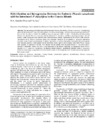Please use this identifier to cite or link to this item:
https://accedacris.ulpgc.es/handle/10553/77375
| DC Field | Value | Language |
|---|---|---|
| dc.contributor.author | González Pérez,Miguel Ángel | en_US |
| dc.contributor.author | Sosa, Pedro A. | en_US |
| dc.date.accessioned | 2021-01-28T14:39:53Z | - |
| dc.date.available | 2021-01-28T14:39:53Z | - |
| dc.date.issued | 2009 | en_US |
| dc.identifier.issn | 1874-3986 | en_US |
| dc.identifier.uri | https://accedacris.ulpgc.es/handle/10553/77375 | - |
| dc.description.abstract | The proportion of hybridization and introgression between the endemic Phoenix canariensis (Canarian date palm) and the introduced P. dactylifera (date palm), were characterized using a multilocus isozyme genotype, based on 17 isozyme loci. In order to evaluate the multilocus isozyme genotype’s ability to detect hybridization and introgression between the endemic Phoenix canariensis and the introduced P. dactylifera, multilocus genotype data from pure and putative hybrid populations were analyzed with a Bayesian-based method, implemented in the STRUCTURE software. The identity of all Phoenix canariensis plants was confirmed. However, in the putative P. dactylifera individuals examined, some of them were designated as hybrid, and others as Canarian date palms. Individuals from each species were clustered separately, while putative hybrid individuals shared ancestors from clusters where both Phoenix species were assigned. In agreement with this, FCA showed that the hybrids were localized between P. canariensis and P. dactylifera individuals’ clouds, but with a closer proximity to the former, suggesting an introgression from Phoenix dactylifera to P. canariensis. In addition, the Bayesian cluster revealed a geographical structure within P. canariensis relative to island origin, so populations from the western islands of the archipelago were clustered together and separately from eastern islands | en_US |
| dc.language | eng | en_US |
| dc.relation.ispartof | The Open Forest Science Journal | en_US |
| dc.source | The Open Forest Science Journal [ISSN 1874-3986], v. 2, 78-85 | en_US |
| dc.subject | 241714 Genética vegetal | en_US |
| dc.subject.other | Phoenix canariensis | en_US |
| dc.subject.other | P. dactylifera | en_US |
| dc.title | Hybridization and introgression between the endemic Phoenix canariensis and the introduced P. dactylifera in the Canary Islands | en_US |
| dc.type | info:eu-repo/semantics/article | - |
| dc.type | Article | - |
| dc.description.lastpage | 85 | en_US |
| dc.description.firstpage | 78 | en_US |
| dc.relation.volume | 2 | en_US |
| dc.investigacion | Ciencias | en_US |
| dc.type2 | Artículo | - |
| dc.description.numberofpages | 8 | en_US |
| dc.identifier.ulpgc | Sí | en_US |
| dc.contributor.buulpgc | BU-BAS | en_US |
| item.grantfulltext | open | - |
| item.fulltext | Con texto completo | - |
| crisitem.author.dept | GIR IUNAT: Biología Integrativa y Recursos Biológicos | - |
| crisitem.author.dept | IU de Estudios Ambientales y Recursos Naturales | - |
| crisitem.author.dept | Departamento de Biología | - |
| crisitem.author.orcid | 0000-0002-8619-3004 | - |
| crisitem.author.parentorg | IU de Estudios Ambientales y Recursos Naturales | - |
| crisitem.author.fullName | González Pérez,Miguel Ángel | - |
| crisitem.author.fullName | Sosa Henríquez, Pedro Antonio | - |
| Appears in Collections: | Artículos | |
Page view(s)
70
checked on May 27, 2023
Download(s)
106
checked on May 27, 2023
Google ScholarTM
Check
Share
Export metadata
Items in accedaCRIS are protected by copyright, with all rights reserved, unless otherwise indicated.
